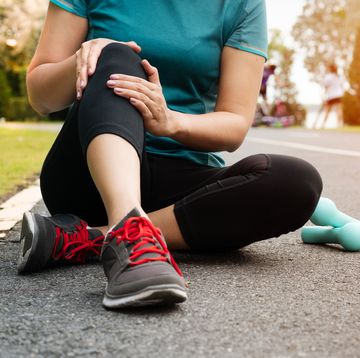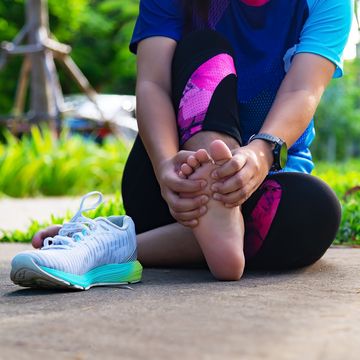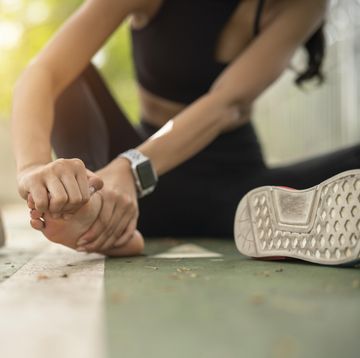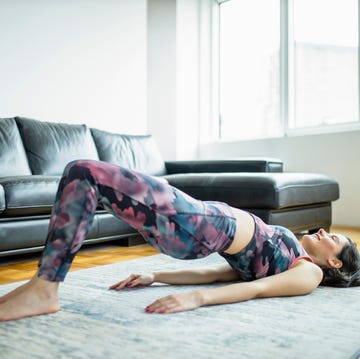Though categorically not bad for your knees, running can be the cause of certain knee pain or injuries. One of the more common ones is patellar tendinopathy, which presents as pain just below the knee cap and can also cause stiffness and weakness around the knee.
The patellar tendon runs from the knee cap to the tibia (shin bone) and transmits the force from the quadriceps muscles. Sports that involve running and jumping place a lot of stress on the patellar tendon – in fact, patellar tendinopathy is often called ‘jumper’s knee’ due to its high prevalence in sports involving jumping, such as basketball and volleyball. It’s typically considered an overuse injury, with symptoms being linked to the tendon reacting to an increase in load.
*Disclaimer: The advice in this guide should not replace a medical assessment and/or advice. The only way to receive a proper injury diagnosis – and personalised treatment plan – is to see a health professional.*
What everyone's reading
What is the difference between patellar tendinopathy and patellar tendonitis?
The term ‘tendonitis’ means inflammation of the tendon and used to be the common name for pain in tendons, such as the patellar tendon or achilles tendon. Research challenged whether these tendons truly were inflamed and, as a result, the term changed to ‘tendinopathy’, which more broadly covers painful conditions involving the tendon. So, essentially, the two terms mean the same thing.
What causes patellar tendinopathy in runners?
Tendons are strong, resilient structures that can adapt to the stress placed upon them – but if this load increases too rapidly, they become painful and irritated. So, if a runner increases their training volume, frequency or intensity too rapidly, the tendon may react and become sore. Certain types of training, like downhill running, place a lot of load on the patellar tendon, as do plyometrics (such as jump squats).
Other factors may play a role in the development of patellar tendinopathy, such as weakness in the quads or over-striding while running (which can increase patellar tendon load).
What are the symptoms of patellar tendinopathy?
Pain from patellar tendinopathy is usually within the tendon just below the knee cap. There can sometimes be visible swelling and it can be tender to press on. Symptoms are usually aggravated by running, jumping and going down stairs, although it does depend on how irritable the pain is.
Squats can be painful, especially with added load or if you're going deeper into range. The tendon can also become sore and stiff with prolonged sitting, especially if the knee is very flexed.
Tendon pain can be present at the start of activity and then ‘warm up’ and settle as you continue. The tendon’s reaction to load can take time to develop, so often there is a reaction to overload the day after doing aggravating activity. Patellar tendinopathy can present with early morning stiffness, which is also common in the achilles and other sites of tendon pain.
How can you determine the difference between this and other knee injuries?
Forming a diagnosis and creating a treatment plan that works for you are complex, so it’s best to see a health professional for their expert guidance.
There are other causes of knee pain that are common in runners, too, such as patellofemoral pain syndrome (runner's knee) and iliotibial band syndrome.
Patellofemoral pain syndrome tends to present as pain around and beneath the patellar, rather than within the tendon. It’s less likely to cause early morning stiffness or the same ‘warm up’ response described above. (You can find out more about runner's knee by reading our treatment guide, listening to our recent episode of the Runner's World podcast about the condition, or watching the video below.)
Iliotibial band syndrome usually causes more lateral pain around the outside of the knee. It often comes on at a fairly consistent point during the run and worsens with continued running beyond this point. (You can learn more by reading our IT band treatment guide or watching the video below.)
What is the best treatment for patellar tendinopathy in runners?
Tendons can be tricky and individual treatment will vary, so we recommend seeing a health professional for a programme tailored to your needs. However, there are four general phases when managing patellar tendinopathy:
- Calm it down
- Improve strength
- Build back up
- Keep it happy
Phase 1: Calm it down
The first step with tendon pain is to calm down symptoms. As we’ve said, the major driver of pain is overuse, so the key way to settle symptoms is to bring down the load on the tendon to a manageable level. For some people this may mean a break from sport, so it’s important to seek advice from your health professional on when rest from running is needed and how to return.
In many cases, complete rest isn’t needed and is often counterproductive, as it leads to weakness and de-conditioning. Instead, we use a traffic light system to guide activity:
This can take some trial and error, but the idea is to find a level of exercise where symptoms are mild and settle quickly afterwards. It’s better to start at a lower level and increase than to work too hard and have a lasting flare up.
The obvious thing to adapt here is running: cutting back on distance and downhill or faster sessions if it's provoking symptoms. However, it also helps to consider other factors that aggravate your pain, such as prolonged sitting, jumping sports and other plyometric exercises. If you’re unsure where to start, list the top three to five activities that seem to increase your pain the most. They are usually the first things you’ll want to cut back on or take a break from until things settle.
Isometric exercises such as static knee extension can help to maintain strength and reduce pain:
Isometric knee extension
- Use a seated knee extension machine (or resistance band if unavailable) with a manageable amount of resistance.
- Start with the knees at 90 degrees and straighten to approximately 60 degrees, pushing against the resistance.
- Hold this position for 10 seconds and repeat five times.
- If this is easy, gradually increase the hold time up to a maximum of 45 seconds.
- Progress further by increasing the weight
Your health professional can help you to find the right start point in terms of resistance/reps/sets. They may also be able to help with treatments such as taping, which some people find very beneficial.
Phase 2: Improve strength
It isn’t just muscles that get stronger with exercise – tendons do, too. The right rehab exercises for patellar tendinopathy can restore quad strength and help to prepare the tendon for the demands of running.
The traffic light approach above can be used to find the right resistance level. Again, if in doubt, start a little easier and build up.
A typical approach would be three exercises in a rehab session, done two to three times per week. Repetitions and sets may vary, but many people do well with three sets of around 10 to 12 reps where they gradually increase the load (rather than the number of reps/sets).
Here are some exercise options for patellar tendinopathy:
Seated knee extension
- Use a seated knee extension machine (or resistance band if unavailable). Start with a weight that feels manageable in terms of symptoms.
- Start with the knees at 90 degrees and slowly straighten them against the load, then lower the weight again.
- Aim for three sets of 10 to 12 reps, two to three times per week.
- Progress by adding load or moving to single leg.
If you’re unable to fully straighten your knees or can’t manage three sets of 10 to 12 reps, then use a lighter weight.
Leg press
- Use a leg press with a weight that feels manageable in terms of symptoms.
- Start with the knees at 90 degrees and slowly straighten them against the load, then lower the weight again.
- Aim for three sets of 10 to 12 reps, two to three times per week.
- Progress by adding load or moving to single leg.
If you’re unable to fully straighten your knees or can’t manage three sets of 10 to 12 reps, then use a lighter weight.
Gym ball squat
- Place a gym ball behind you, between your back and the wall.
- Squat to around 80 to 90 degrees or as far as is comfortable, then straighten your knees to return to the start position.
- Aim for three sets of 10 to 12 reps, two to three times per week.
- Progress by adding load, for example by holding a kettlebell as shown.
A standard squat is a good alternative if you don’t have access to a gym ball.
Single-leg decline squat
- Place a weighted plate or slant board under your heel.
- Balance on one leg, holding on for support if needed.
- Bend your knee forward to around 30 to 40 degrees (or as far as is comfortable).
- Aim for three sets of 10 to 12 reps, two to three times per week.
- Progress by adding weight.
This is a more challenging exercise and can provoke symptoms. As with all exercises, be guided by your health professional on what is right for you.
Phase 3: Build back up
Once symptoms are under control and you’ve found a manageable level of running and rehab exercises, you can then start to gradually build your running back up. It’s best to focus on one area at a time, such as training distance, frequency or speed.
What often works well is initially sticking to a maximum of three runs per week, so rehab can be continued on your non-running days. Then, build one area for three to four weeks before having a recovery week (see the example programme below).
If your symptoms are delayed (and appear the day after a run, for example), then it’s often best to progress in clear increments, testing the response at each level. For example, run for five minutes and see how it responds the next day. If there’s no lasting reaction, progress by adding two minutes onto the next run and, again, see what the response is like before progressing.
Phase 4: Keep it happy
One of the most frustrating things about tendon pain is that it often recurs. The usual story is that symptoms settle and people return to running but try to make up for lost time by doing more. They build too rapidly and the tendon reacts again. It’s not unusual for people to repeat the cycle several times – it’s very common when you love to run and just want to get back to it.
To keep the tendon happy, focus on consistency rather than rapid results. Plan training so that it progresses gradually and includes adequate recovery. The strength training can be continued to maintain strength and tendon health, with once-weekly sessions often working well for this.
General health influences tendon health, too, so take good care of yourself with enough sleep and a balanced diet.

Tom Goom is a physiotherapist and running specialist whose website running-physio.com has gained a worldwide audience. He’s based at Body Rehab Studios in Hove and travels internationally to teach about running injury and how to treat it.




















